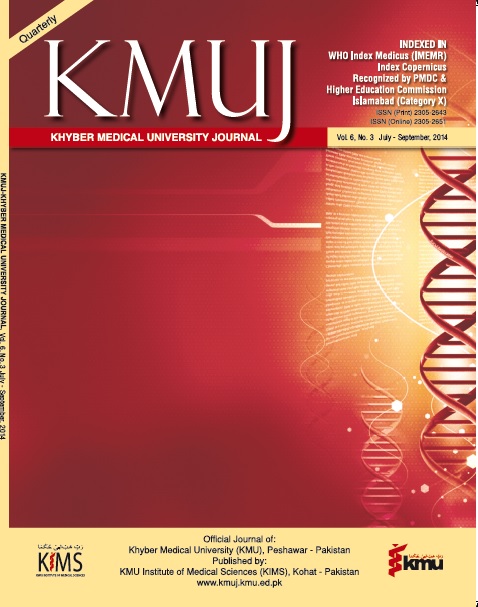TREATMENT OUTCOMES OF TUBERCULOSIS PATIENTS REGISTERED AT DOTS CENTRE KOHAT
Main Article Content
Abstract
OBJECTIVE: To find out the treatment outcomes of patients suffering from tuberculosis at DOTs centre.
METHODOLOGY: This descriptive analytical study on tuberculosis and its treatment outcomes was conducted at DHQ Teaching Hospital Kohat from July 2008 to January 2011, over a period of two and a half years. Data was interpreted by using SPSS version 14.
RESULTS: In this study total number of 1760 patients are included, out of which 943(53.6%) are females and 817 males (46.4%). AFB positive patients are 43%, extra pulmonary 32.2% and sputum negative pulmonary cases are 24.6%. Treatment outcomes showed 574 cured, 726 treatments completed 422 defaults, 16 deaths and one referred to other treatment centre. Seven patients remained 3 AFB positive till 7th month.
CONCLUSION: The proportion of favorable outcome was below the goal set by the WHO. Tuberculous case management needs to be investigated to reduce the chances of high default rate.
Article Details
Work published in KMUJ is licensed under a
Creative Commons Attribution 4.0 License
Authors are permitted and encouraged to post their work online (e.g., in institutional repositories or on their website) prior to and during the submission process, as it can lead to productive exchanges, as well as earlier and greater citation of published work.
(e.g., in institutional repositories or on their website) prior to and during the submission process, as it can lead to productive exchanges, as well as earlier and greater citation of published work.
References
Volmink J & Garner P. Directly observed therapy for treating tuberculosis. In: The Cochrane Library, Issue 1 (2004). John Wiley & Sons Ltd, Chichester.
Raviglione MC, Snider DE & Kochi A. Global epidemiology of tuberculosis: morbidity and mortality of a worldwide epidemic. Journal of the American Medical Association 1995:273; 220–6.
Wilkinson D. High compliance tuberculosis treatment programme in a rural community. Lancet 1994; 343:647–8.
Chowdhury AMR, Chowdhury A, Islam MN, Vaughan JP. Control of tuberculosis by community health workers in Bangladesh. Lancet 1997:350; 169–72.
Kamolratankul P, Sawert H, Lertmaharit S. Effectiveness of directly observed treatment of pulmonary tuberculosis in Thailand. Transactions of the Royal Society of Tropical Medicine and Hygiene 1999:93; 552–7.
Zwarenstein M, Schoeman J, Vundule C, Lombard C, Tatley M. Randomised controlled trial of self-supervised and directly observed treatment of tuberculosis.Lancet 1998 :352: 1340–3.
Khan MA, Walley J, Witter SN, Imran A, Safdar N. Costs and cost effectiveness of different DOTS strategies for treatment of tuberculosis: economic results of a randomised controlled trial in Pakistan. Health Policy and Planning 2002 :17; 178–86.
WHO Global Tuberculosis Programme. TB : WHO report on the tuberculosis epidemic 1997. Geneva: World Health Organization,1997.)
Pamela Orr. Adherence to tuberculosis care in Canadian Aboriginal populations Part 1: definition, measurement, responsibility, barriers. International Journal of Circumpolar Health 2011:70(2); 113–127.
Ministry of Health of PRC (2009) National TB Control Program Implementation Guide in China (2008 Edition). Beijing.
Xu L, Gai R, Wang X, Liu Z, Cheng J. Socio-economic factors affecting the success of tuberculosis treatment in six counties of Shandong Province, China. Int J Tuberc Lung Dis 2010:14(4); 440–6.
Xu W, Lu W, Zhou Y, Zhu L, Shen H. Adherence to anti-tuberculosis treatment among pulmonary tuberculosis patients: a qualitative and quantitative study. BMC Health Services Research 2009 : 9; 169–76.
WHO, author. WHO declares TB an emergency in Africa. 2005. [1 June 2009]. Press release. Available at: http://www.who.int/mediacentre/news/ releases/2005/africa_emergency/en/index.html.
WHO, author. Global tuberculosis control-surveillance, planning, financing. 2007. [July 15 2009].
Borgdroff, Floyd K, Broekmans JF. Intervention to reduce tuberculosis mortality and transmission in low- and middle-income countries. Bulletin on the World Health Organization. 80:217–227.
WHO, author. Treatment of tuberculosis. Guidelines for national programs. 2003. [July 15 2009].
Tahir NB, Tahiruddin Q, Noor I, et al. Prevalence of HIV in Tuberculous patients presenting to TB clinic of a divisional headquarters hospital. GJMS 2012, Vol. 10, No. 1 :123-6.
Wright J, Walley J, Philip A, Pushpananthan S, Dlamini E, Newell J, Dlamini S. Direct observation of treatment for tuberculosis: A randomized controlled trial of community health workers versus family members. Tropical Medicine & International Health. 2004; 9:559–65.
Tobe Gai RY, Xu LZ, Song PP, Huang Y (2011) Migrant population, directly-observed treatment strategy (DOTS), tuberculosis control, China. Bio Science Trends 5(6): 226–230.
Haiju D, Yihui Z, Yuyan Z, Biao X (2007) Multifactor Study on treatment compliance of non-resident TB patients in Putuo District, Shang. Chinese Preventive Medicine 8(5): 568–572 (in Chinese).
China Global Fund Project Office (2006) The Implementation of Floating Population TB Control Pilot Project (China Global Fund TB Program Round 5). Beijing, China (in Chinese).
Gurpreet Kaur, N.K. Goel, Dinesh Kumar, A.K. Janmeja, H.M. Swami, and Meenu Kalia. .Treatment Outcomes of Patients Placed on Treatment Under Directly Observed Therapy Short-Course (Dots). Lung India. 2008 Apr-Jun; 25(2): 75–7.
Lillebaek T, Poulsen S, Kok-Jensen A. Tuberculosis treatment in Denmark: treatment outcome for all Danish patients in 1992. Int J Tuberc Lung Dis. 1999; 3(7):603–12.
Farah M, Tverdall A, Steen T, Heldall E, Brantsaeter A, Bjune G. Treatment outcome of new culture positive pulmonary tuberculosis in Norway. BMC Public Health. 2005;5:14. doi: 10.1186/1471-2458-5-14.
Euro TB and the national coordinators for tuberculosis surveillance in the WHO European Region. Surveillance of tuberculosis in Europe. Report on tuberculosis cases notified in 2006. Institut de veille sanitaire, Saint-Maurice, France; 2008.
Munro SA, Lewin SA, Smith HJ, Engel ME, Fretheim A, Volmink J: Patient adherence to tuberculosis treatment: a systematic review of qualitative research. PLoS medicine 2007, 4(7):e238.
Garner P, Smith H, Munro S, Volmink J: Promoting adherence to tuberculosis treatment. Bulletin of the World Health Organization 2007, 85(5):404-06.
Tuula Vasankari, Pekka Holmström, Jukka Ollgren, Kari Liippo, and Petri Ruutu. Treatment outcome of extra-pulmonary tuberculosis in Finland: a cohort study BMC Public Health. 2010; 10: 399.
A.A. Chughtai, C.R. MacIntyre, Y.A. Wang, Z. Gao l. Treatment outcomes of various types of tuberculosis in Pakistan, 2006 and 2007. EMHJ 2013:19 535-40.
